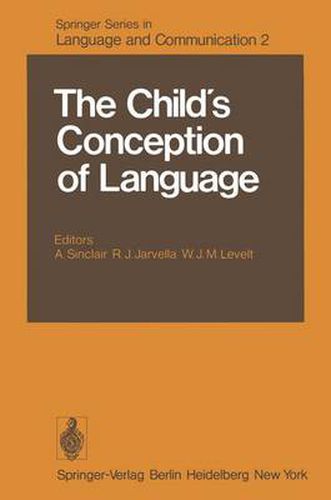Readings Newsletter
Become a Readings Member to make your shopping experience even easier.
Sign in or sign up for free!
You’re not far away from qualifying for FREE standard shipping within Australia
You’ve qualified for FREE standard shipping within Australia
The cart is loading…






This title is printed to order. This book may have been self-published. If so, we cannot guarantee the quality of the content. In the main most books will have gone through the editing process however some may not. We therefore suggest that you be aware of this before ordering this book. If in doubt check either the author or publisher’s details as we are unable to accept any returns unless they are faulty. Please contact us if you have any questions.
It is obvious that the growing child manifests an increasing understanding of his language and facility to use it. A major part of the child lan guage literature is concerned with the child’s developing linguistic and communicative competence. Scattered evidence also shows, however, that children become progressively more aware of language as Zanguage. It is interesting to consider in what ways the internal structure and mechanisms of language become more accessible. Little is known about linguistic aware ness of this kind, the role it plays, or how it develops. When the new Projektgruppe fUr Psycholinguistik of the Max-Planck Gesellschaft was founded, the child’s conception .of language, in analogy to Piaget’s child’s conception of the physical world, become one of the research unit’s topics of study. As previous work on linguistic awareness was largely amorphous, we first organized a kind of conference workshop with some of those who had worked in the area. The aims of this meeting were to map out the field of study, detail the phenomena of interest, and define major theoretical issues. The meeting took place just after the creation of the project group, on May 3-7, 1977. The participants were psychologists and linguists who had either published work on metalinguistic issues in child language, or who could be expected to contribute substantially to the discussion. This book is a direct outcome of that conference, though it is not a complete reflection of the papers presented, or of the discussion that took place.
$9.00 standard shipping within Australia
FREE standard shipping within Australia for orders over $100.00
Express & International shipping calculated at checkout
This title is printed to order. This book may have been self-published. If so, we cannot guarantee the quality of the content. In the main most books will have gone through the editing process however some may not. We therefore suggest that you be aware of this before ordering this book. If in doubt check either the author or publisher’s details as we are unable to accept any returns unless they are faulty. Please contact us if you have any questions.
It is obvious that the growing child manifests an increasing understanding of his language and facility to use it. A major part of the child lan guage literature is concerned with the child’s developing linguistic and communicative competence. Scattered evidence also shows, however, that children become progressively more aware of language as Zanguage. It is interesting to consider in what ways the internal structure and mechanisms of language become more accessible. Little is known about linguistic aware ness of this kind, the role it plays, or how it develops. When the new Projektgruppe fUr Psycholinguistik of the Max-Planck Gesellschaft was founded, the child’s conception .of language, in analogy to Piaget’s child’s conception of the physical world, become one of the research unit’s topics of study. As previous work on linguistic awareness was largely amorphous, we first organized a kind of conference workshop with some of those who had worked in the area. The aims of this meeting were to map out the field of study, detail the phenomena of interest, and define major theoretical issues. The meeting took place just after the creation of the project group, on May 3-7, 1977. The participants were psychologists and linguists who had either published work on metalinguistic issues in child language, or who could be expected to contribute substantially to the discussion. This book is a direct outcome of that conference, though it is not a complete reflection of the papers presented, or of the discussion that took place.